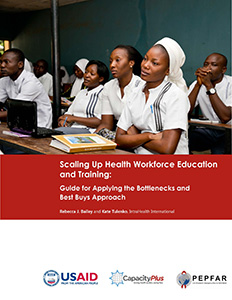
Bottlenecks and Best Buys
Scaling Up Health Workforce Education and Training:
Guide for Applying the Bottlenecks and Best Buys Approach
Health workers are a cornerstone of efforts to improve health service coverage and achieve better health outcomes. However, in 2013 the Global Health Workforce Alliance and World Health Organization estimated a global deficit of 7.2 million doctors, nurses, and midwives. Clearly, more health workers must be educated and trained. Unfortunately, the capacity to increase the supply of health workers is constrained by the limited number of institutions that produce health workers and the scarcity of resources to scale up education and training.  CapacityPlus’s Bottlenecks and Best Buys Approach is designed to help educational institutions identify obstacles to increasing the production of competent and qualified graduates that can be overcome through limited yet strategic investments. This guide draws from the project’s experience of adapting and applying the approach in more than 30 nursing, midwifery, medical, health assistant, and community health extension worker schools, both public and privately owned, in seven African countries. It identifies the stakeholders who should be involved, the steps in conducting a bottlenecks assessment, and a method for using the results to identify and build consensus on the most effective and affordable actions (best buys) for overcoming bottlenecks.
CapacityPlus’s Bottlenecks and Best Buys Approach is designed to help educational institutions identify obstacles to increasing the production of competent and qualified graduates that can be overcome through limited yet strategic investments. This guide draws from the project’s experience of adapting and applying the approach in more than 30 nursing, midwifery, medical, health assistant, and community health extension worker schools, both public and privately owned, in seven African countries. It identifies the stakeholders who should be involved, the steps in conducting a bottlenecks assessment, and a method for using the results to identify and build consensus on the most effective and affordable actions (best buys) for overcoming bottlenecks.
The guide also provides tools and examples for strategic steps in the approach, such as engaging stakeholders, conducting a situation analysis, defining the school’s scale-up goal, leading group interviews, analyzing the results, and presenting the final bottlenecks and best buys report to external stakeholders and potential investors.
Access the guide:
The annexes are available as Word documents:
- Annex 6: Optional Surveys, Observations, and Interviews
- Annex 6.1: Sample Student Questionnaire
- Annex 6.2: Sample Educator Questionnaire
- Annex 6.3: Sample Observation Checklist: School Facilities and Infrastructure
- Annex 6.4: Sample Observation Checklist: Clinical Practice Facilities
- Annex 6.5: Sample Key Informant Interview Guide
In addition, the following resources may be of interest:


